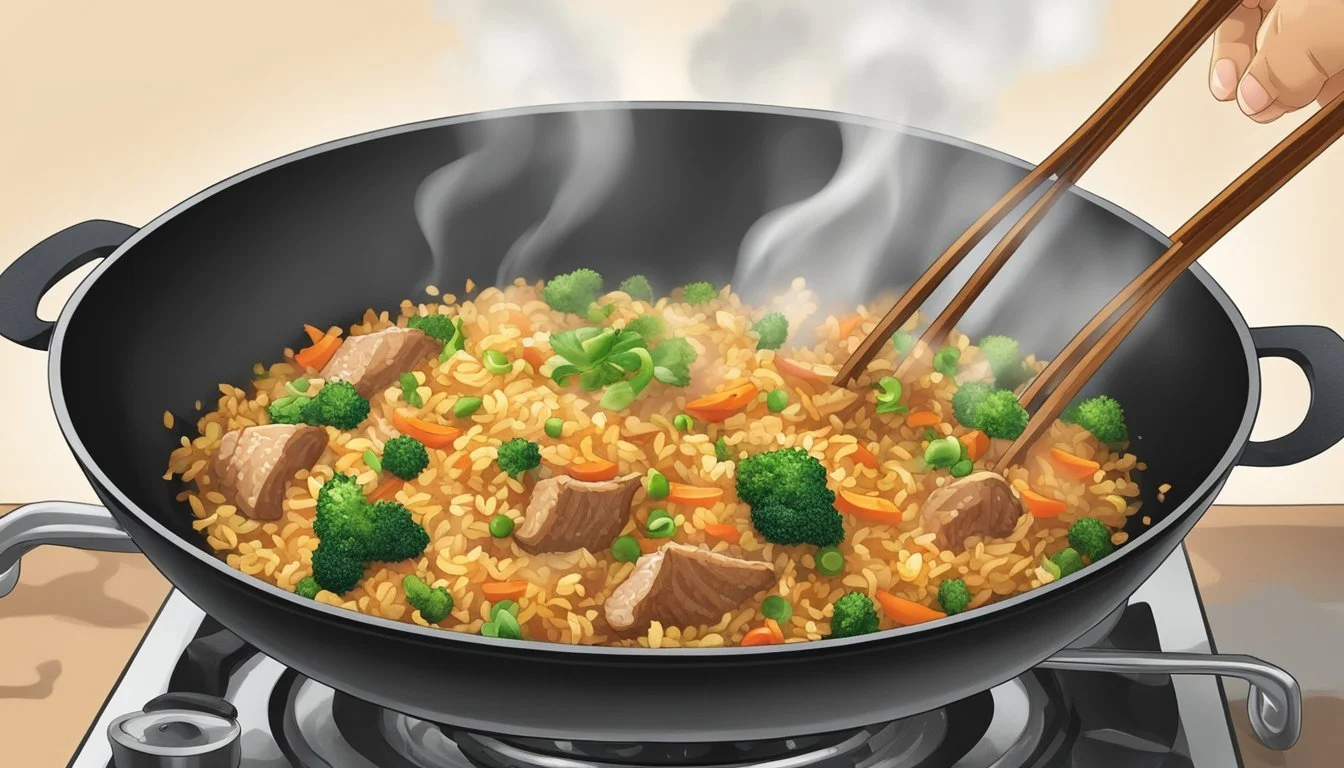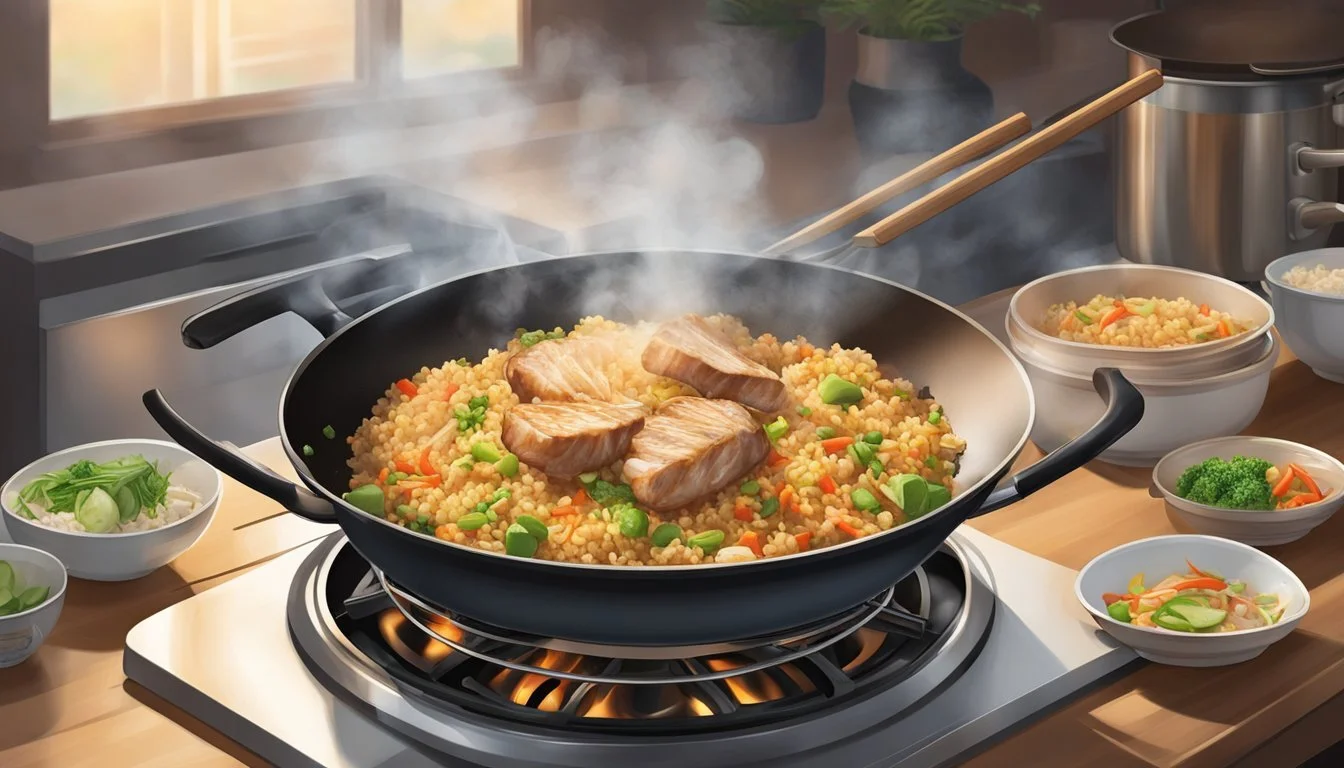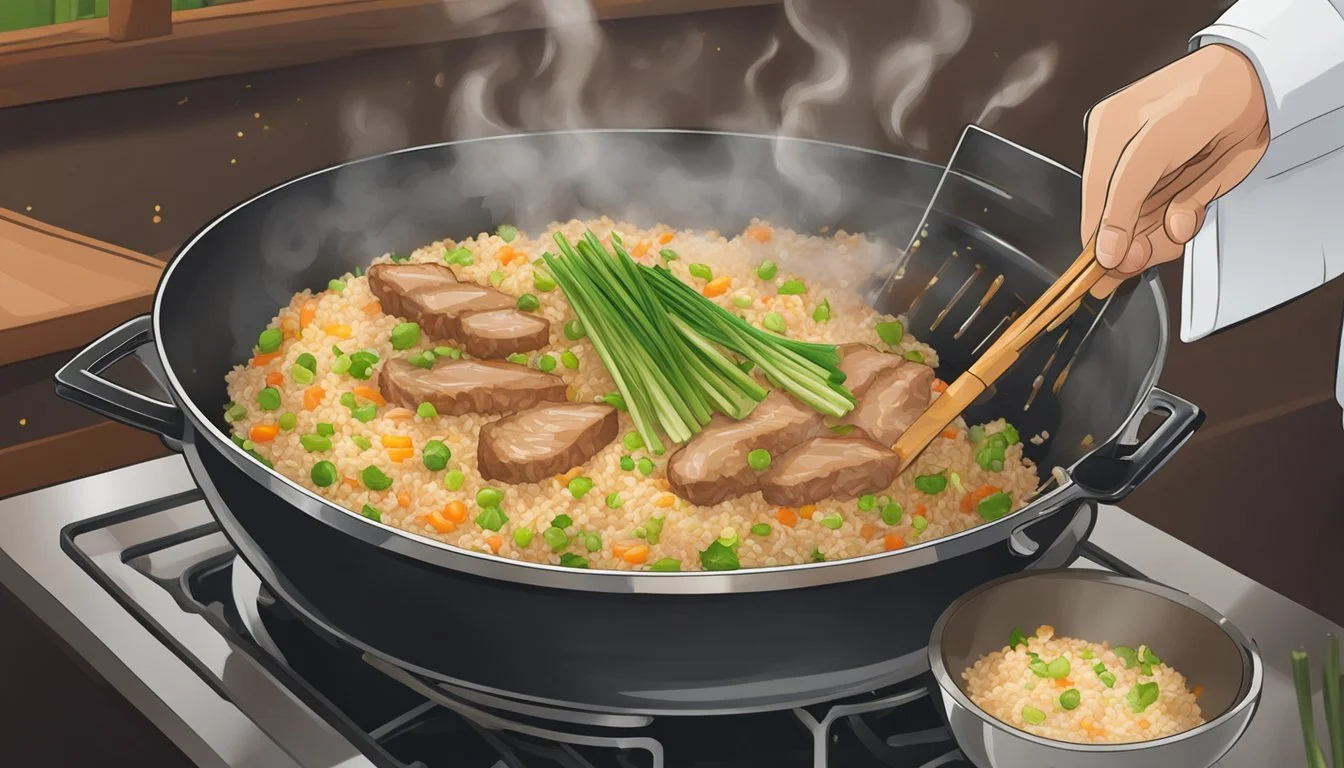Best Way to Reheat Pork Fried Rice
Tips for Preserving Its Signature Flavor
Reheating pork fried rice (What wine goes well with rice?) so that it retains its tantalizing smokiness and rich flavors is an art of its own. Leftovers often run the risk of becoming dry or losing their original texture and taste. However, the right reheating technique can restore the dish’s just-cooked quality. The key lies in understanding the elements that made the rice appealing in the first place: the slight crispness of the grains, the savory depth of the pork, and the balance of vegetables and seasoning.
In pursuit of the best methods for revitalizing leftover pork fried rice, one must consider the tools and resources available at home. The most common approaches utilize the stovetop and the microwave, each offering its unique advantages. The stovetop method is preferred for achieving an even distribution of heat and maintaining the slight crispness that is characteristic of a well-cooked fried rice. Conversely, the microwave offers a quick and convenient option, though it may require extra care to avoid sogginess.
Each method, when executed properly, can ensure that the reheated pork fried rice is both safe to consume and delightful in flavor. It’s important to add the right amount of moisture to prevent the rice from drying out, as well as to distribute heat evenly to avoid any cold spots. In doing so, the reheated dish can rival the original serving in both taste and satisfaction.
Understanding the Challenges of Reheating Fried Rice
When reheating pork fried rice, maintaining the original texture and flavor while ensuring food safety can be a complex task. The key challenge is to restore the dish's smoky essence without inviting bacterial growth.
Preserving Texture and Flavor
Pork fried rice is prized for its distinct texture and flavor. Texture is characterized by individual grains that are slightly firm but not hard, and a general lack of clumping. Flavor is typically a blend of savory smokiness with spices and ingredients used during the initial cooking. When reheating, the key is to avoid:
Overcooking, which can lead to dryness and loss of flavor.
Underheating, which may result in a soggy texture and muted flavors.
Leftovers should be handled gently to maintain this balance. Heat distribution is crucial; for stovetop reheating, one must:
Heat the pan with a bit of oil or broth.
Add fried rice, stirring frequently to evenly distribute heat.
For microwave reheating:
Use a microwave-safe container.
Add a splash of water to prevent drying.
Cover with a lid, slightly ajar, and stir midway through heating.
Preventing Food Poisoning
Food poisoning is a serious concern when reheating leftovers, especially dishes like pork fried rice. The bacteria Bacillus cereus is commonly associated with rice and can survive some cooking processes. To minimize the risk,
Ensure fried rice reaches an internal temperature of 165°F (74°C).
Store leftovers properly, refrigerating within two hours of cooking to prevent bacterial growth.
Consume reheated fried rice within one day and do not reheat more than once.
By following these guidelines, one can safely enjoy deliciously reheated pork fried rice without compromising on texture, flavor, or health.
Preparation Steps Before Reheating
Before attempting to reheat pork fried rice, proper preparation ensures that the dish maintains its flavor and texture. Two key steps are crucial: safe storage and temperature adjustment.
Safely Storing Leftover Fried Rice
One should store leftover fried rice in the fridge within two hours of cooking to prevent bacterial growth. It is essential to use an airtight container to seal the rice, as this minimizes exposure to bacteria and retains its moisture. Refrigeration should maintain a temperature below 40°F (4°C) to ensure safety and preserve the quality of the fried rice.
Bringing Fried Rice to Room Temperature
Before reheating, it is advisable to bring the pork fried rice to room temperature. Take the airtight container out of the fridge and let it sit on the counter for about 30 minutes. This step allows for more even reheating, preventing the rice from being too cold in the middle while the outside aspects may overheat.
Choosing the Right Reheating Method
When reheating pork fried rice, selecting the appropriate method is critical to maintaining its smoky flavor and ensuring that the rice does not become overly dry or soggy.
Pros and Cons of Microwave Reheating
Pros: The microwave is a quick and convenient option for reheating pork fried rice. It is best for those who are short on time.
Cons: It can unevenly heat the rice, sometimes leading to hot spots and dry or tough patches.
| Microwave Reheating | Pros | Cons |
|---------------------|----------------------------------|---------------------------------------|
| Speed | - Fastest reheating option | - Can create uneven heating |
| Convenience | - Minimal effort and monitoring | - May leave rice dry or chewy |
| Consistency | - Can retain moisture with care | - Risk of sogginess without attention |Oven Reheating Technique
Oven Method: Preheat the oven to 350°F. Spread the pork fried rice in an even layer on a baking dish, adding a few sprinkles of water to prevent drying. Cover the dish with foil and heat for 10-15 minutes.
Stovetop Reheating for Optimal Results
Stovetop Method: Heat a pan over medium heat, adding a small amount of oil or broth to maintain moisture. Stir the pork fried rice frequently for even reheating and to preserve its smoky flavor.
Alternative Methods: Air Fryer and Broth Steaming
Air Fryer: For a quick and slightly crispy texture, an air fryer can be set to 350°F and the pork fried rice reheated for a few minutes until warm.
Broth Steaming: Adding a small amount of chicken or vegetable broth to the rice while reheating can enhance flavor and prevent the rice from drying out. Steaming in a covered pot creates a gentle heating environment.
Detailed Reheating Instructions
Proper reheating of pork fried rice is essential to maintain its texture and flavor. This section provides steps for reusing a microwave, oven, stovetop, and air fryer to ensure the rice is moist, heated evenly, and retains that sought-after smoky taste.
Microwave Reheating Steps
Place the fried rice in a microwave-safe dish.
Stir in a small amount of water or oil to keep the rice moist.
To reheat, set the microwave power to 50% and cover the dish with a lid or a wet paper towel to promote steam circulation. Typically, heat for 1-2 minutes, stir, and repeat if necessary, checking frequently to avoid overcooking.
Oven Reheating Steps
Preheat the oven to 350°F (175°C).
Place the rice in an oven-safe or baking dish.
Add a few tablespoons of water and mix through the rice for an even distribution of moisture. Cover the dish tightly with aluminum foil, and bake for 15-20 minutes, stirring halfway through to ensure even heating.
Stovetop Reheating Steps
Heat a pan, skillet, or wok on medium heat.
Add a small amount of oil to the pan for crispness.
Once the pan is hot, add the pork fried rice. Stir continually for even heating and to reintroduce the smoky flavor. For extra moisture, one may add water or broth occasionally during cooking, which typically takes about 10 minutes.
Using an Air Fryer
Preheat the air fryer to around 370°F (187°C).
Place the rice in the air fryer basket or tray.
Lightly sprinkle water over the rice to prevent it from drying out. Cook for 3-4 minutes, shake or stir, and continue cooking if necessary. The air fryer helps maintain the crispness of the rice while ensuring it is heated through.
Enhancing Flavors During Reheating
When reheating pork fried rice to restore its signature smoky flavor and maintain texture, strategic addition of moisture and fresh ingredients proves crucial. Here's how one can achieve this.
Adding Moisture with Water and Other Liquids
Reheated fried rice often loses moisture, leading to a dry texture. To counteract this, gently stir 1-2 tablespoons of water or broth into the rice before reheating. The liquid will steam during the heating process, helping the rice grains regain their suppleness. Those aiming for an enhanced flavor might opt for a splash of soy sauce; its savory umami can revive the rice's original taste while adding moisture.
Water/Broth: 1-2 tablespoons per cup of rice
Soy Sauce: 1 teaspoon per cup of rice for additional flavor
Incorporating Fresh Ingredients
Fresh ingredients can invigorate pork fried rice with both texture and flavor. Consider sautéing diced onions or vegetables before mixing them into the rice. The added ingredients bring a crispness and can capture some of the lost smokiness when stir-fried on high heat. For a protein boost and extra richness, one can stir in a scrambled egg, cooking it lightly before combining with the rice. Lastly, seasoning with fresh spices, such as a pinch of garlic powder or white pepper, can accentuate the dish’s warm, aromatic qualities.
Onions/Vegetables: Sauté until crisp-tender before mixing
Egg: Scramble and mix in for richness
Spices: Season to taste for warmth and aroma
Finishing Touches for Perfect Fried Rice
The final steps in reheating fried rice are crucial to ensure it regains its signature crispy texture and is seasoned appropriately to elevate its flavors.
Restoring Crispiness and Avoiding Sogginess
To maintain the desirable crispiness of fried rice, whether it be pork or chicken fried rice, one must approach reheating with careful attention to moisture levels. It's essential to use the stovetop method for optimal control. They should heat a pan with a small amount of oil—just enough to lightly coat the rice without making it greasy. Stirring continuously is paramount to prevent the rice from becoming mushy or burning. This method helps to maintain a fluffy texture throughout. Moreover, for each cup of rice, they can introduce a few tablespoons of water or broth to replenish moisture lost during refrigeration without causing sogginess.
Heat the pan with a small amount of oil or butter.
Stir continuously to prevent sticking.
Add water or broth sparingly to avoid mushiness.
Properly Seasoning After Reheating
Once the fried rice is heated through and has achieved the desired level of crispiness, seasoning is the last step they should not overlook. A touch of soy sauce can be added to not only enhance the flavor but also restore some of the rice's original color. However, they should be cautious to ensure the rice does not become overly salty. If the fried rice tastes bland, they may consider adding fresh spices to bring back the dish's aromatic essence. It's essential to taste and season sparingly after reheating since the rice has already been seasoned once during the initial cooking process.
Add soy sauce for enhanced flavor and color.
Use fresh spices to revive the dish's aroma.
Taste test before and after adding additional seasoning.
Safety Tips and Best Practices
Properly reheating leftover pork fried rice not only enhances its taste but also ensures food safety. One should take steps to avoid overcooking, which can affect the dish's flavor and quality, and to ensure that rice is heated evenly to prevent food poisoning.
Preventing Overheating and Uneven Heating
To avoid overheating and ensure even heat distribution when reheating pork fried rice:
Begin with medium-high heat and add a small amount of oil, water, or broth to a pan or wok. This prevents the rice from drying out.
Stir frequently to distribute the heat thoroughly and prevent any cold spots, which can harbor bacteria.
Use a non-stick skillet or wok for better control of the heating process and to ensure that the rice does not stick and burn.
Checking for Internal Temperature
Monitoring the internal temperature is essential to avoid food poisoning:
The USDA recommends that leftover dishes should be reheated to an internal temperature of 165°F to ensure that all potential bacteria are killed.
Use a food thermometer to check the temperature in different areas of the fried rice, especially the thickest parts.
By following these guidelines, one can safely enjoy leftover rice with its original smoky and flavorful taste preserved.
Proper Storage After Reheating
Ensuring that pork fried rice remains delectable after reheating hinges on proper storage techniques. The section below outlines the steps one should follow to maintain the dish's quality.
Using Appropriate Containers
Choosing the Right Container: Post-reheating, the individual must transfer the pork fried rice into an airtight container. This preserves its moisture and prevents odor absorption from the fridge.
Fridge Storage: For short-term storage, utilizing glass or BPA-free plastic containers is advised. They should ensure the pork fried rice cools to room temperature before sealing and placing in the fridge. The cool temperature in the fridge is ideal for keeping the rice fresh for up to 3-5 days.
Freezer Storage: For extending the shelf life, they may opt for freezer-safe airtight containers or heavy-duty freezer bags. The pork fried rice should be portioned out to avoid thawing more than needed when it’s time to reheat.
Securing the Lid: The individual must tightly secure the container's lid or use plastic wrap to shield the rice from external contaminants and moisture loss. This step is critical for preserving the fried rice’s flavor and texture.
Labeling and Dating: Lastly, they should always label the container with the date of storage to track its freshness duration, especially in the freezer where the rice can be stored for up to one month.
By following these detailed and specific storage recommendations, the individual guarantees that their leftovers are safeguarded against spoilage and are safe for consumption when they choose to enjoy them again.
Comparative Analysis: Reheating Related Dishes
Comparing reheating methods across different dishes reveals the best practices for maintaining flavor and texture. This section explores how these techniques apply to fried rice variations and other common leftover foods.
Reheating Varieties of Fried Rice
Leftover Fried Rice: Retention of the smoky, just-stir-fried taste in leftovers like pork or chicken fried rice is achievable by carefully reheating. Using a stovetop method, they can heat a skillet to medium-high, add a touch of oil, and spread the rice evenly for quick warming. Stirring occasionally helps restore the fresh flavor while preventing burning.
Chicken Fried Rice: Similar to pork fried rice, chicken fried rice requires gentle reheating to avoid drying out the protein. They can introduce a small amount of moisture if needed, which assists in reviving the original taste and keeping chicken tender.
Reheating Method Strengths Weaknesses Microwave Quick, convenient May result in uneven heating Stovetop Can enhance flavor by recreating the cooking process, good for single servings or a family meal Requires attention to prevent overcooking
Applying Techniques to Other Leftover Foods
Pizza: The goal with pizza is often to preserve the crispiness of the crust without drying out the toppings. They can achieve this by reheating in a skillet over medium heat or in a preheated oven until the cheese has melted and the crust crisps up.
Fried Chicken: With fried chicken, maintaining the crunch while ensuring the meat stays moist is key. They can place it in a preheated oven on a wire rack, allowing the hot air to circulate to keep the coating crisp.
Rice Dishes and Protein: When reheating rice dishes and meals with protein for breakfast, lunch, or dinner, one should consider the introduction of steam or a small amount of liquid to prevent drying. Covering the dish with a lid or foil when using an oven can help retain moisture.
Food Type Suggested Reheating Method Pizza Skillet on medium heat or oven Fried Chicken Oven on a wire rack Rice Dishes Stovetop with added moisture or oven with a lid or foil to retain steam
By applying these reheating techniques tailored to the specific needs of each dish, one can enjoy leftovers that are as close to the original meal as possible.






